5.4.2: Plane (PP) Polarized Light and Cross Polarized (XP)Light
- Page ID
- 19127
For routine viewing, petrologists and mineralogists use polarizing microscopes with orthoscopic illumination, and with, or without, the upper polarizer inserted. Without the upper polarizer, we see a sample in plane-polarized light, also called PP light. With the upper polarizer, we see it in cross-polarized light, also called crossed polars or XP light. Grain size, shape, color, cleavage, and other physical properties are best revealed in PP light. The optical properties refractive index and pleochroism are also determined using PP light. We use XP light, sometimes focused with conoscopic and Bertrand lenses, to determine other properties including retardation, optic sign, and 2V. To see examples of all of these properties and many views of the most common minerals in thin section go to our Optical Mineralogy website.
We will discuss mineral properties in XP light later in this chapter. For now, we will concentrate on plane polarized light.
5.4.2.1 Characteristics Seen in Plane Polarized (PP) Light
•Opaque and Nonopague Minerals
Opaque minerals, in contrast with nonopaque minerals, do not allow any light to pass through them. So, opaque grains appear black in both PP and XP light, even if we rotate the stage. The most common opaque minerals include graphite, oxides such as magnetite or ilmenite, and sulfides such as pyrite or pyrrhotite. It is sometimes possible (especially if a thin section does not have a cover slip) to remove a slide from the microscope stage, hold it up and turn it around, and reflect light off mineral grains to see the reflected color. A silver color suggests the grains are graphite or oxides and a golden color suggests they are sulfides.
•Crystal Shape and Habit
When viewing minerals in PP light, we can pick out different minerals based on their grain shapes and habit. For example, Figure 5.29a below shows a large rounded grain of garnet containing many sharp fractures. Figure 5.29b contains lathes of clear plagioclase (Plag), an equant grain of olivine (oliv) and an almost rectangular grain of clinopyroxene (Cpx). Figure 5.29c has a large blade of light blue kyanite in the center of the view. Both Figures 5.29a and c contain flakes of brownish biotite (Bi).

•Cleavage
The garnet, cordierite, and olivine seen in Figure 5.29 show no cleavages (although the garnet does display many fractures). Many minerals, however, exhibit cleavage, usually appearing as straight parallel cracks through a grain. When we can see cleavage with a microscope, it can be an important diagnostic tool. We use qualitative terms such as perfect, good, fair, and poor (discussed in Section 3.5.2, Chapter 3) to describe the ease with which a mineral cleaves in different directions. Minerals with one or more good or perfect cleavages show cleavage most of the time, while those with only poor cleavage may not. Additionally, minerals with low relief do not show cleavage as readily as those with high relief. We can overcome this problem sometimes by closing down the substage diaphragm, which narrows the cone of light hitting the thin section and increases contrast.
Minerals may have zero, one, two, three, four, or even more cleavages, but because thin sections provide a view of only one plane through a mineral grain, we rarely see more than three at a time. And minerals that have elongate habits exhibit different cleavage patterns when viewed in a cross section than they do when viewed in a longitudinal section.
When we look at a mineral grain in thin section we are looking in a singular direction through the mineral. But cleavage planes are oriented in three dimensions (3D). So observed cleavage angles depend on grain orientation. If a mineral has two cleavages that intersect at 60°, the cleavages will appear to intersect at any angle from 0° to 60° depending on grain orientation. So we must often examine many grains (or one with a known orientation determined by examining an interference figure) to learn the maximum, and true, 3D cleavage angle.
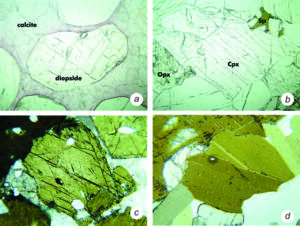
Figure 5.30a shows a grain of diopside with two perpendicular cleavages. Figure 5.30b shows augite, a pyroxene closely related to diopside, but the grain is at a different orientation and shows only one direction of cleavage. Figure 5.30c shows a brown amphibole grain with two cleavages that intersect at about 60° and 120°. If the grain were oriented differently, only one cleavage might be visible. Figure 5.30d shows several grains of biotite. The tilted greenish rectangular grain near the lower left corner shows good mica cleavage (cleavage in one direction). The large darker brownish grain that fills most of the view does not because the view is looking down on top of a flake.
•Color and Pleochroism
When we talk about the color of a mineral in thin section, we are talking about its color when viewed with PP light, not when viewed with XP light. Many minerals appear colored in hand specimen, and some show color when viewed with a microscope. But it is rare for the reflected color of a hand specimen to have any resemblance to the transmitted color seen in thin section.
The difference is due to several things. Most importantly, when we see color in a hand sample, we are seeing the color of light reflected by the sample. If all colors reflect, the sample appears white. If none reflect, it is black. And if only some wavelengths reflect we see various colors. This is not what happens when we view minerals in thin section.
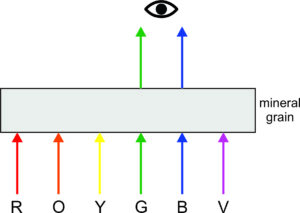
When we see color in thin section (using PP light) we are seeing transmitted colors. These are the colors of light passing through a mineral grain (Figure 5.31). Crystals absorb some wavelengths and transmit others. If all colors are transmitted, we see white. If none are transmitted, we see black. And in other cases we see colors of different hues depending on the mineral’s absorption. But many minerals in thin section are not thick enough to significantly absorb specific wavelengths of light. So minerals in thin section often appear light colored even if the mineral has strong coloration in hand specimen.
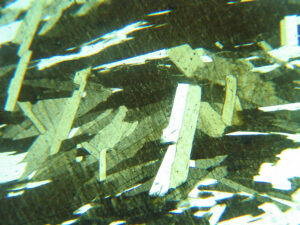
Figure 5.32 shows a mica schist, viewed with PP light. The minerals present include biotite in various shades of greenish brown and tan, clear elongated clear crystals of muscovite and somewhat equant quartz (on the lower right edge). Biotite is generally black when viewed in hand specimen but always is lighter colored in thin section, like the biotite seen here. Different grains of biotite have different colors because they have different atomic orientations with respect to the light vibration direction. In this thin section, the few grains of muscovite (white mica) have the same shape as the biotite (because they are both micas) but show no coloration.
Many minerals absorb different wavelengths of light depending on light vibration direction. So colors we see in thin section generally change when we rotate the microscope stage. This is because rotating the stage changes the orientation of the mineral’s crystal structure with respect to the polarized light passing through the lower polarizer. We call this property (changing colors with stage rotation) pleochroism. Biotite is an example of a mineral that normally displays marked pleochroism. If we rotated the sample seen in Figure 5.32, biotite colors would vary between various shades of brown or tan. The exact colors depend on the biotite composition. For a typical grain, color varies between two hues. The range of color, however, depends on grain orientation in the thin section.
Video 2: Explanation of color and pleochroism (3 minutes)
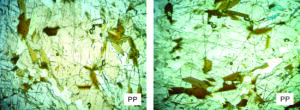
Pleochroism is an especially useful diagnostic property when identifying some minerals, but it can be overlooked because it may be subtle. For example orthopyroxenes are nearly colorless in thin section, but some show a faint pleochroism from (what mineralogists call) pink to green. The photos in Figure 5.33 show the same large grain of orthopyroxene but the orientation of the grain is 90o different in the two views. Light pinkish color can be seen in the photo on the left, and light green color in the photo on the right. Pleochroism of pyroxenes is an important property because it sometimes distinguishes the two major pyroxene subgroups: orthopyroxenes and clinopyroxenes.
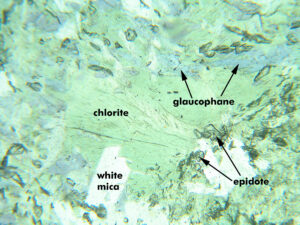
In contrast with orthopyroxenes, many amphiboles display strong colors and a very noticeable pleochroism in thin section. For minerals, such as amphiboles, that have noticeable pleochroism, reference tables give pleochroic formulas that describe the colors seen when looking at grains in different directions through the crystal’s atoms. The hornblende in Figure 5.4, for example, is pleochroic in various shades of green. And the biaxial mineral glaucophane (an amphibole shown in Figure 5.34) has pleochroism described by the pleochroic formula:
blank• X = colorless or pale blue
blank• Y = lavender-blue or bluish green
blank• Z = blue, greenish blue, or violet
X, Y, and Z refer to light vibrating parallel to each of three mutually perpendicular vibration directions in a crystal. In thin sections, glaucophane’s colors vary within the limits described for X, Y, and Z, depending on the crystal orientation, as we rotate the microscope stage. Figure 5.34 shows blue glaucophane in a rock from Panoche Pass, California. Different grains of glaucophane show different hues due to different grain orientations. Figure 6.88 (Chapter 6) shows a hand sample of glaucophane; it is one of a small number of minerals that have colors in thin section that are quite similar to those seen in hand sample.
For another example of pleochroism, consider the biotite in Figure 5.32. It is pleochroic in browns, and a standard pleochroic formula for biotite might be:
blank• X = colorless, light tan, pale greenish brown, or pale green
blank• Y ≈ Z = brown, olive brown, dark green, or dark red-brown
•Relief and Becke Lines
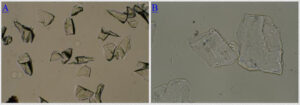
If epoxy or some other material with significantly different refractive index surrounds mineral grains, the grains will stand out. This is the case for the garnet in epoxy in Figure 5.35A. But, if mineral grains are surrounded by material that has a similar refractive index to the mineral, they may be almost invisible unless the mineral is one of the few minerals with very strong coloration. This is the case for the halite grains seen in a grain mount in Figure 5.35B. As the difference between the index of the surrounding material and the mineral decreases, the boundary between the two becomes less easily distinguished. The term relief describes the contrast between the mineral and its surroundings.
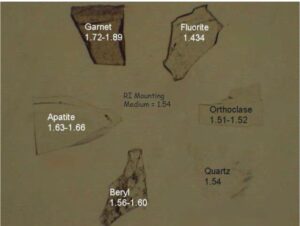
In grain mounts, we often look at mineral fragments surrounded by immersion oil with a specific refractive index. Figure 5.36 shows how relief changes depending on the difference between refractive index of a mineral and surrounding oil. The oil has refractive index of 1.54, but the minerals mostly do not. The garnet and fluorite both have high relief. The other minerals have variable relief, and the quartz almost disappears because quartz and the surrounding oil have the same refractive index.
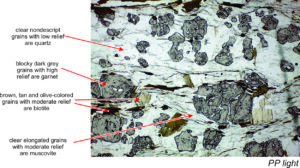
Grains mounts show relief well, but minerals in thin sections also show relief. The relief depends on the difference in the indices of refraction of the mineral and the material (today usually a special type of epoxy) in which it is mounted. Thin section epoxy typically has an index of refraction of 1.54-1.56. As the difference in indices increases, relief becomes more noticeable. We can see relief with either a monocular or a binocular microscope, but more easily with the latter. Some, not all, people see relief in three dimensions when viewing a thin section with a binocular microscope.
Minerals with high refractive indices show high positive relief because their index of refraction is greater than that of the epoxy. They also show structural flaws, such as scratches, cracks, or pits, more than those with low refractive indices. The thin section in Figure 5.37 contains very high relief garnet, moderate relief biotite and muscovite, and low relief quartz. A few minerals (such as calcite) display variable relief with stage rotation; variable relief is a useful diagnostic property for calcite.
Most minerals that appear to have high relief have high refractive indices. But some minerals (fluorite, for example) with very low refractive indices show high relief (termed negative relief) in thin section because their index of refraction is much lower than that of the epoxy. We do not differentiate between positive and negative relief in this book; for most purposes, we need only to know whether a mineral displays high, medium, or low relief – which really means whether it stands out in thin section.
When we immerse a mineral grain in liquid that has refractive index different from the mineral’s, refraction occurs and some light rays bend toward the medium with the higher refractive index. Other light rays are completely reflected because they hit the mineral-liquid interface at an angle greater than the critical angle of refraction. But overall, light interacts with a mineral grain as if the grain were a small lens (Figure 5.38).
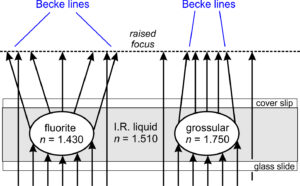
If nmineral < nliquid, light rays are refracted and diverge after passing through the grain. If nmineral > nliquid, light rays are refracted and converge after passing through the grain. If we slowly lower the microscope stage, shifting the focus to a point above the mineral grain, a bright narrow band of light called a Becke line appears at the interface and moves toward the material with higher refractive index. A complementary but more difficult to see dark band moves toward the material with lower refractive index.
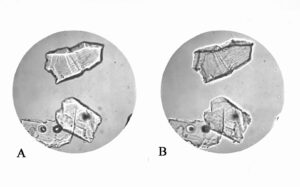
Figure 5.39 shows fragments of a mineral in a refractive index oil significantly different from the mineral. In Figure 5.39A, the microscope focus has been raised (the stage has been lowered), and a white line moved into mineral grains that have higher refractive index than surrounding oil. In Figure 5.39B, the focus was raised (the stage was lowered) and the white line moved outward into oil that has higher refractive index than the mineral grains.
Although not as straightforward, we can also use Becke lines to compare the relief of minerals in thin sections by purposely focusing and defocusing the microscope while we examine a grain boundary. We also compare relief by noting how well a mineral appears to stand out above another.
Video 3: a good video about Becke lines (5 minutes)
5.4.2.2 Characteristics Seen in Cross Polarized (XP) Light
•Anisotropic vs Isotropic Minerals
Most minerals are anisotropic. For example, you do not have to look very long at the atomic structures of sheet silicates (Figure 13.30 in Chapter 13) to see that the atom order is different in different directions; they are anisotropic. Because atomic order is not the same in different directions through an anisotropic crystal, refractive index varies with direction. In contrast, a glass, such as window glass or obsidian, is isotropic because it has a random atomic arrangement. Randomness means that, on the average, the structure and refractive index are the same in all directions. Minerals whose crystals belong to the cubic system are isotropic because their atomic arrangement is the same along all crystallographic axes. Minerals belonging to other crystal systems are anisotropic.
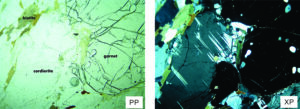
Isotropic minerals are easy to spot in thin sections. When viewed with a polarizing microscope and XP light, they are always extinct, which means they remain black as the stage rotates, no matter what their orientation is on the stage. For example, Figure 5.40 shows PP and XP views of a gneiss containing cordierite and garnet. In the XP view on the right, the garnet is black (isotropic) but the cordierite, which shows stripes due to twinning, is not (anisotropic). There are few common isotropic minerals, but the most common are garnet, sphalerite, and fluorite. Usually we can tell these and the few other isotropic minerals apart by looking at color, relief, habit, and cleavage. Sometimes (poorly made) thin sections contain holes, places with no mineral and only epoxy. The holes appear isotropic and can occasionally be mistaken for isotropic minerals.
In contrast with isotropic minerals, randomly oriented anisotropic mineral crystals do not normally appear extinct when viewed in XP light. But if we rotate the microscope stage, they go extinct briefly every 90°. There is, however, a complication. If an anisotropic crystal is oriented so that light passes through it parallel to a special direction called an optic axis, it will appear to be isotropic. (This occurs when the optic axis is perpendicular to the microscope stage.) In this special orientation the mineral will remain extinct as we rotate the stage.
Fortunately, the number of optic axes in anisotropic minerals is limited to one (in uniaxial minerals) or two (in biaxial minerals). In thin sections, the odds of the optic axis being vertical and parallel to the light beam are small, and confusing isotropic and anisotropic minerals is rarely a problem. When in doubt, we can distinguish them most easily by looking at multiple grains of the same mineral (they cannot all be oriented with their optic axes perpendicular to the stage). We can also distinguish isotropic from anisotropic crystals using conoscopic illumination because anisotropic minerals transmit some conoscopic light and display interference figures (discussed later), while isotropic minerals do not.
•Views Using Crossed Polars
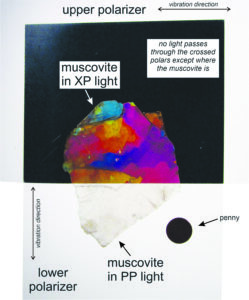
Figure 5.41 shows a ragged flake of muscovite (white mica) with one rectangular polarizing filter below it and another above it. We oriented the filters perpendicularly. So we see black where they overlap and there is no mica. But, where it is present, the mica changes the vibration direction of the light so it can pass through the top polarizer.
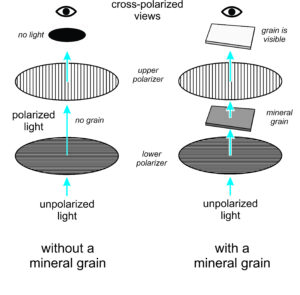
Besides changing direction of polarization, when viewed with XP illumination, crystals also change white light to different colors. These are interference colors and, in Figure 5.41, they do not match the color of the mica at all. They appear as various shades of blue, red, orange, and purple. These colors do not result from absorption of different wavelengths by the mineral (which is how minerals get their color when viewed in PP light). Instead, the colors are artifacts of polarized light passing through two polarizers and a crystal. The interference colors in this figure are blotchy and variable because the flaky mica is thicker in some places than in others.
Figure 5.42 shows the origin of the phenomena seen in the previous figure, but with geometry more similar to what happens with a microscope. When no mineral grain is in the path of the light, east-west polarized light encounters a north-south polarizing filter. So, no light is transmitted and only a black color is seen. But, when a flake of mica is present, the grain changes light polarization, so some light gets through the upper polarizer. During this process double refraction occurs (discussed later in this chapter) and the result is interference colors.
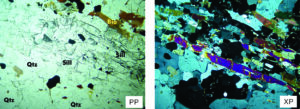
We only see interference colors if we insert the upper polarizer and view a thin section in XP light. For example, the photos in Figure 5.43 show PP and XP views of the same area on a thin section. In the PP view, brown-tan biotite and opaque magnetite (black and unlabeled) are easily seen. But quartz and sillimanite are clear and uncolored.
The XP view in Figure 5.43 is more colorful because it shows interference colors. Interference colors for quartz vary with crystal orientation and would change from white to black if we rotated the microscope stage. Feldspars, and many other minerals have similar white to black interference colors. But most minerals display colors of some sort that may be brighter and more pronounced than colors seen when we view the same mineral in PP light. For example, the long needle of sillimanite in this thin section is clear in PP light. It shows bright purplish-blue colors (that are not completely uniform because the needle is thicker in some places than in other) in XP light. Other grains of sillimanite, which are blocky end-views of needles, show gray or yellow interference colors.
Interference colors are unrelated to the true color of a mineral. And interference colors depend on grain orientation, so different grains of the same mineral in one thin section normally display a range of interference colors. Different minerals display different ranges of interference colors, so color variation is a useful tool for mineral identification. Colors also vary with the thickness of grains, so it is important that thin sections be of uniform thickness. Additionally, the edges of some grains, grains near the edge of a thin section, or grains next to holes in a thin section (places where the sample is thin), may display abnormal interference colors.
•Q. What is the Origin of Interference Colors? A. Double Refraction
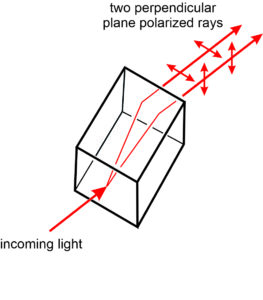
When polarized light encounters an isotropic mineral, it slows as it passes through the mineral, but maintains its character when it emerges. Upon entering an anisotropic crystal, however, light is normally split into two polarized rays, each traveling through the crystal along a different path with a slightly different velocity and refractive index (Figure 5.44). For uniaxial minerals, we call the two rays the ordinary ray (O ray), symbolized by ω, and the extraordinary ray (E ray), symbolized by εʹ. The O ray travels a path predicted by Snell’s Law, while the E ray does not. The directions of the O-ray and E-ray vibrations depend on the direction the light is traveling through the crystal structure, but as seen in Figure 5.44 the vibration directions of the two rays are always perpendicular to each other when they emerge from the crystal.
Things are a bit more complicated for biaxial minerals. But, as with uniaxial minerals, a polarized ray encountering a biaxial crystal normally splits into two rays vibrating perpendicularly to each other. One ray emerges from the crystal before the other, so we call the two rays the fast ray and the slow ray. (We also sometimes use the same terms, fast and slow, for the O ray and the E ray of uniaxial minerals, but sometimes the O ray is the fastest and sometimes the E ray is.)

We call the splitting of a light beam into two perpendicularly polarized rays double refraction. All randomly oriented anisotropic minerals cause double refraction. We can easily observe it if we place clear calcite over a piece of paper on which a line, dot, or other image has been drawn (as in Figure 5.45). Two images appear, one corresponding to each of the two rays. A thin piece of polarizing film placed over the calcite crystal would verify that the two rays are polarized and vibrating perpendicular to each other. If we rotate either the film or the crystal, every 90° one ray becomes extinct, and we will see only one image. Calcite is one of a few common minerals that exhibits double refraction easily seen without a microscope, but even minerals that exhibit subtler double refraction can be tested using polarizing filters. Gemologists use this technique to tell gems from imitations made of glass. Glass, like all isotropic substances, does not exhibit double refraction.

Consider a thin section and light entering an anisotropic mineral grain (Figure 5.46). Double refraction occurs, and as the two rays pass through the crystal (uniaxial or biaxial), they travel at different velocities unless they are traveling parallel to an optic axis. Because the rays travel at different velocities, their refractive indices must be different. The difference in the indices of the fast ray and the slow ray (nslow – nfast) is the apparent birefringence (δʹ). It varies depending on the atomic orientation in the crystal and the direction light is traveling. δʹ ranges from zero to some maximum value (δ) controlled by the crystal structure. The maximum birefringence (δ) is a diagnostic property of minerals.
When the slow ray emerges from an anisotropic crystal, the fast ray has already emerged and traveled some distance. This distance is the retardation (Δ), labeled in Figure 5.46. Retardation is proportional to both the thickness (t) of the crystal and to the birefringence in the direction the light is traveling (δʹ):
blankΔ = t x δʹ = t x (nslow – nfast)
Most anisotropic minerals have birefringence between 0.01 and 0.20. The birefringence and retardation of isotropic crystals are always zero. No double refraction occurs, and all light passes through isotropic crystals with the same velocity because the refractive index is equal in all directions.
•Crystals Between Crossed Polars
As pointed out previously, when viewing with the upper polarizer in place – under crossed polar (XP) light – we can differentiate isotropic and anisotropic crystals. If we are looking at an isotropic crystal using XP light, it will remain extinct (dark) through 360° of stage rotation. This is because the light emerging from the mineral retains the polarization it had on entering and will always be east-west polarized. It cannot pass through the upper polarizer, oriented at 90° to the lower polarizer. The effect is the same as if no mineral were on the stage.
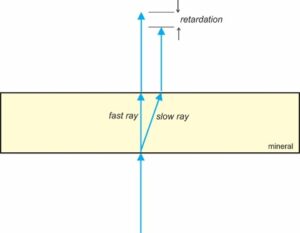
But when we view an anisotropic crystal with XP light, light is split into two rays – a fast ray and a slow ray – unless we are looking down an optic axis (Figure 5.47). The two rays, after emerging from the crystal, travel on to the upper polarizer where they are resolved into one ray with north-south polarization. Because the vibration directions of the fast and slow rays are normally not perpendicular to the upper polarizer, only some components of both pass through the upper polarizer and combine to produce the light reaching our eye. As we rotate the microscope stage, however, the relative intensities of the two rays emerging from the crystal vary. Every 90°, the intensity of one is zero, and the other is vibrating perpendicular to the upper polarizer. Consequently, no light passes through the upper polarizer and the crystal appears extinct every 90°.
If we used a monochromatic light (one wavelength) source in our microscope and looked at an anisotropic crystal under XP light, it would go from light to complete darkness as we rotate the stage. Extinction would occur every 90°, and maximum brightness would be at 45° to the extinction positions. However, most polarizing microscopes use polychromatic light. Because of dispersion, double refraction is slightly different for different wavelengths. Minerals with high dispersion may never appear completely dark, but most come close.
Video 4: Explanation of double refraction with animation (2 minutes)
Video 5: What Happens at the Upper Polarizer? (3 minutes)
•Interference Colors
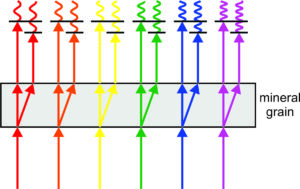
When white light passes through an anisotropic mineral, all wavelengths are split into two polarized rays vibrating perpendicularly. The slow ray lags behind the fast ray by a distance equivalent to the retardation. Different colors have different wavelengths, so when the rays leave the crystal, the fast and slow rays for any color may be in phase, completely out of phase or somewhere between depending on the retardation compared with wavelength (Figure 5.48). The waves will not initially interfere because they are vibrating in perpendicular directions and are not following the same paths. But when the north-south components of the two rays are combined at the upper polarizer (where the filter constrains them to vibrate north-south), constructive interference occurs for some colors, and destructive interference for others. Most wavelengths will not be completely in phase or out of phase, so some intermediate amount of interference will occur.
When we look at a mineral under XP light, we see one color. It is mostly a combination of those wavelengths that are in phase or partially in phase, and is missing wavelengths that are out of phase or mostly out of phase. Interference colors depend on the retardation of different wavelengths, which in turn depends on the orientation, birefringence, and thickness of a crystal. Interference colors change intensity and hue as we rotate the stage; they disappear every 90°, when the mineral goes extinct.
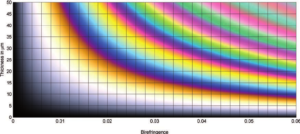
Retardation, and thus interference colors, vary with mineral birefringence and thickness. The Raith–Sørensen chart seen in Figure 5.49 shows the relationships. Retardation is proportional to birefringence and grain thickness, and it increases diagonally from zero in the bottom left corner to about 3,000 nm in the upper right corner.
Interference colors vary in hue and intensity with stage rotation, but this chart shows “maximum” interference colors that we may see halfway between extinctions. Grains that are very thin or that have very low birefringence display up to white interference colors. Those that are thicker and have greater birefringence display other colors. Overall, the colors become less pronounced as retardation increases.
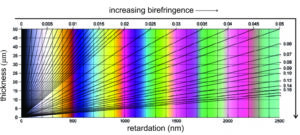
Figure 5.50 shows the same information as the previous figure but the axes have been changed. This kind of chart, called a Michel-Lévy Color Chart, is more commonly used by mineralogists than the Raith–Sørensen chart above. In a Michel-Lévy chart, the horizontal axis is retardation; it directly correlates with interference color (shown as vertical color swatches). The vertical axis is grain thickness. The diagonal lines and numbers on the top and right side of the chart show birefringence. (Birefringence was the horizontal axis in the Raith–Sørensen chart above in Figure 5.49.) Notice that the interference colors repeat hues, but become more washed-out (paler), as retardation increases.
Very low-order interference colors, corresponding to a retardation of less than 200 nm, are gray and white. If retardation is slightly greater, yellow, orange, or red interference colors will appear when we rotate the stage. These colors, corresponding to retardation of 200 nm to 550 nm, are called first-order colors. As retardation increases further, we see blue, and then colors repeat every 550 nm of retardation, the average wavelength of white light. This is because it does not matter if a wave is 1 wavelength, 2, or 3, behind another – it will still be in phase. And the same holds true for out-of-phase waves – it does not matter if they differ by 1.5, 2.5, etc., wavelengths, they are still out of phase.
So, colors go from gray to red (first order), from violet to red (second order) and then from violet to red again (third order), and continue to repeat. They become more pastel (washed out) in appearance as order increases. Fourth-order colors are often so weak that they appear “pearl” white (because they have a play of color like pearls) and may occasionally be confused with first-order white. So, when describing an interference color, stating both the color and the order is important. For mineral identification, the order is often more important than the color.
Birefringence can be a good tool for mineral identification. Standard thin sections are 30 μm (0.03 mm) thick but sometimes thin sections are poorly made, and often grains are thinner around their edges than in their centers. This chart reminds us that retardation, and thus interference colors, are a product of both thickness and birefringence. Additionally, birefringence depends on mineral orientation. If a mineral is oriented with an optic axis vertical, its birefringence will be zero. And if the optic axis is close to vertical, birefringence may be much less than the maximum it could be. Consequently, when estimating birefringence from interference colors seen in thin section, we must look at multiple grains of the same mineral to make sure we know what the maximum birefringence is.

Figure 5.51 shows PP and XP views of a thin section we saw earlier in this chapter. The rock contains mostly quartz, sillimanite and biotite. A few grains of opaque magnetite (black and unlabeled) are apparent in the PP view. Quartz has birefringence of about 0.01, biotite and sillimanite have greater birefringence. So the quartz shows only white and gray interference colors; the other minerals display bright blues, violets, yellows, and other hues.

Figure 5.52, a slice through the Michel-Lévy chart in Figure 5.50, shows normal interference colors for some common minerals. If thin sections are of uniform thickness (30 μm) and minerals have normal compositions, these are the maximum interference colors that will be seen. Many complicating factors, including how well a thin section was made and the nature of the substage light source, can cause aberrations. Note that some relatively common minerals (titanite, calcite, and dolomite) plot way off-scale to the right on this diagram.
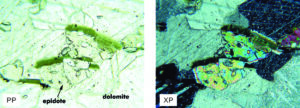
Minerals with very low birefringence that display first-order white, gray, or yellow interference colors include quartz, leucite, nepheline, apatite, beryl, and feldspar. Many other minerals have greater birefringence. For example, biotite and sillimanite, which have intermediate birefringence, display third-order colors. But, birefringence can be much greater.
The epidote seen in Figure 5.53 (XP view) shows blotchy second- and third-order colors. Most of this specimen, however is dolomite. Dolomite has birefringence of about 0.2, which means its interference colors are off the chart – they are very high-order pearly pastels that appear almost white. Some minerals, including dolomite, titanite (sphene), and calcite have very high birefringence. So they commonly show such weak colors that it is impossible to estimate retardation and birefringence with any certainty.
Anisotropic minerals have different refractive indices that vary depending on the path light travels when passing through them. Their optical properties, including birefringence, and thus interference colors, depend on their orientation. For identification purposes, the maximum birefringence (δ), corresponding to the highest-order interference colors, is diagnostic. This may be hard to estimate in grain mounts because mineral thickness varies, making it difficult or impossible to estimate birefringence from interference colors. In thin sections, the task is easier because thickness is known (30 μm) so we can use the Michel-Lévy Chart to determine birefringence from interference color.
It is worth emphasizing that randomly oriented mineral grains may not show maximum interference colors. If minerals are oriented with an optic axis close to vertical, their birefringence may be much less than the maximum it could be. If the optic axis is vertical, the grain will appear extinct. Consequently, when estimating birefringence from interference colors seen in thin section, we must look at multiple grains of the same mineral to make sure we know what the maximum birefringence is. Because we cannot be exact, we normally use qualitative terms such as “low,” “moderate,” “high,” or “extreme” to describe retardation and birefringence.
•Anomalous Interference Colors
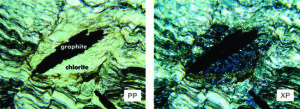
Some minerals display anomalous interference colors. These are colors not represented on the Michel-Lévy Color Chart. Anomalous interference colors may result if minerals have highly abnormal dispersion, if they are deeply colored, or for several other reasons. Minerals that commonly display anomalous inference colors include chlorite, epidote, zoisite, jadeite, tourmaline, and sodic amphiboles. Figure 5.54 shows a phyllite collected from near the Hudson River in Poughkeepsie, New York. In the PP view, chlorite appears drab and green, but in the XP view it displays inky blue interference color. Inky blue color, although not on the Michel-Lévy Chart, is often a key to identifying chlorite in thin section. Some chlorite, however, shows interference colors in other hues.
Video 6: Examples of low, medium, and high-order interference colors in thin section (3 minutes)
Video 7 summarizes fundamental information about interference colors (5 minutes)
•Twinning, Zoning, and Undulatory Extinction
Many minerals twin, and sometimes we can see the twins with a microscope. The dolomite in Figure 5.53, for example, shows stripes due to twinning in both the PP and the XP view. But normally we only see twinning when we cross the polars. Twins show in XP light because different twin domains have different crystallographic orientations. So the domains do not go extinct simultaneously when we rotate the microscope stage.
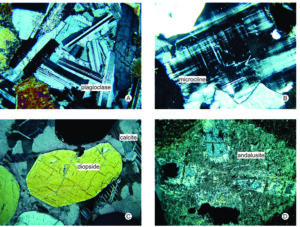
Figure 5.55 shows more examples of twinning. These are XP views of plagioclase, microcline, diopside, calcite, and andalusite. The plagioclase and diopside have lamellar twins (parallel with a long direction) and sharp twin boundaries (although the twins in the diopside are hard to see because they are so thin.) These are examples of contact twins. The calcite, microcline and andalusite grains contain penetration twins that cut across each other.
Twinning is often an excellent way to distinguish different minerals in thin section. Sometimes we describe plagioclase twinning (Figure 5.55a) as zebra stripes, for obvious reasons. The microcline (Figure 5.55b) shows two types of lamellar twins with different orientations. They combine to produce what we call microcline twinning or Scotch plaid twinning. Orthoclase (not shown) often contains simple contact twins. Calcite (Figure 5.55c) is characterized by polysynthetic twins parallel to the long diagonal of its rhombohedral shape. Other carbonates have no twins or have twins parallel to the short diagonal. The andalusite seen above (Figure 5.55d) contains a cross made by two twin domains – few minerals twin this way. Thus, for the feldspars, the carbonates, and for some other minerals, twinning can be a key to identification.
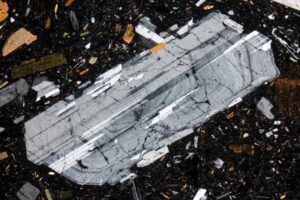
Some mineral grains, most notably those that crystallize from magma over a range of temperature, are heterogeneous. So different parts of grains have different optical properties, producing compositional zonation, commonly just called zoning. Feldspars and other minerals that commonly twin, often show zoning. Figure 5.56 is an example – a zoned plagioclase in rhyolite. The zoning appears as concentric rings that parallel the outside of the crystal, somewhat like tree rings. The rings developed as the grain crystalized from melt. Subsequently the mineral twinned, producing the long lathes parallel to the grain’s long dimensions. Many other minerals, besides plagioclase, can show zoning in thin section.
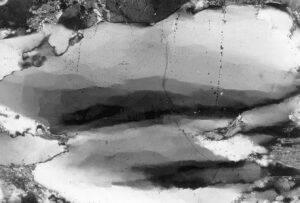
Quartz and some feldspars are known for displaying undulatory extinction when viewed under XP light. This kind of extinction is sometimes confused with compositional zonation. When a grain shows undulatory extinction, it means that different parts of a crystal go to extinction at different times with stage rotation. This gives an overall patchy or blotchy appearance. This property derives from strain imposed on a crystal after it formed. Undulatory extinction is so common in quartz that it is considered a diagnostic property. Figure 5.57 shows several large quartz grains. Portions of each are at extinction but most of the grains are not.
Video 8: twinning and zoning with some great photos (4 minutes)


